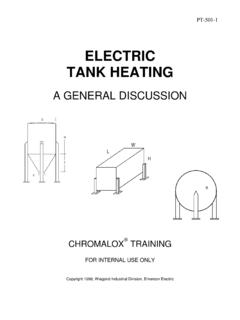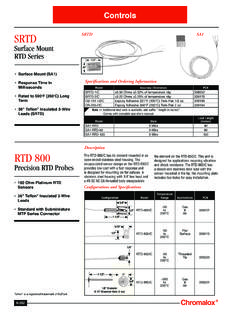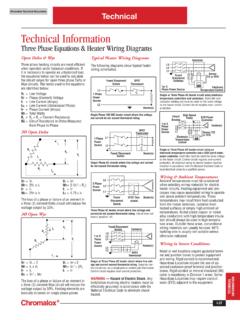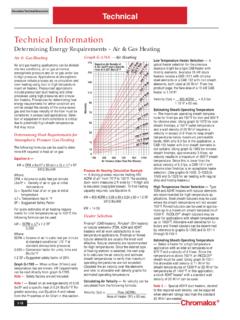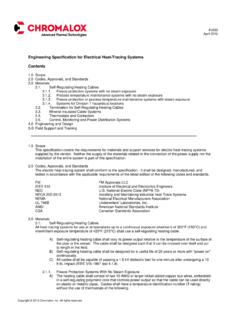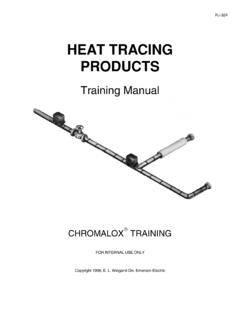Transcription of SCR Power TheorySCR Power Theory Training Manual Training ...
1 PK501-1 SCR Power TheorySCR Power TheorySCR Power TheorySCR Power Theory Training Manual Training Manual Training Manual Training Manual CHROMALOX Training 800-443-2640 Copyright 1997-2001, Chromalox, Inc. PK501-1 Written By Al Roman & Adam Heiligenstein Chromalox Inc. 1382 Heil Quaker Blvd. LaVergne, TN 37086 (615) 793-3900 800 443-2640 Revised 1/2002 The facts and the recommendations made in this publication are based on our own research and the research of others and are believed to be accurate. We cannot anticipate all conditions under which this information and our products or the products of other manufacturers in combination with our products may be used.
2 We accept no responsibility for results obtained by the application of this information or the safety and suitability of our products either alone or in combination with other products. Users are advised to make their own tests to determine the safety and suitability of each such product or product combination for their own purposes. SCR Power Theory - Training Manual CHROMALOX PAGE 1 Copyright 1997-2001, Chromalox, Inc. TABLE OF CONTENTS INTRODUCTION TO SCR Power Power CONTROL Single Phase Typical Closed Loop Mechanical Semiconductor Common Semiconductor Silicon Controlled SCR CONTROL Zero Crossover Zero Crossover Firing Time Demand Oriented Transfer (DOT).
3 13 Time Proportional vs. Demand Oriented NON-ZERO VOLTAGE CROSSOVER Phase Angle Why Not Use Phase Angle Firing On All Applications?..15 Phase Angle/Zero Fire Combination SCR Transformer Coupled Multi-Tap Transformer Coupled Automatic Tap Changing Transformer Coupled SINGLE AND THREE PHASE Power Load Configurations and Typical Three Phase Load THREE PHASE SCR CONNECTION Two Leg SCR Power Three Leg SCR Power Grounded WYE Phase Angle Inside Delta Hybrid Application WATT Power CONTROLLER FEATURES AND Shorted SCR Current Transformer (CT)..33 Partial Load Failure Line Voltage Emergency Shut Down Flexible Input Flexible Line Manual CONTROLLING YOUR MATERIAL AND LABOR ANATOMY OF A Power GLOSSARY OF COMMON Power CONTROL CHROMALOX SCR Power Theory - Training Manual PAGE 2 Copyright 1997-2001, Chromalox, Inc.
4 INTRODUCTION TO SCR Power Theory The purpose of this guide is to teach you the fundamentals of Silicone Controlled Rectifiers (SCR) Power regulators. Since the development of SCR Power controllers in the late 1950 s, the Power handling capabilities of the devices has steadily increased from a few hundred watts to many megawatts. Due to the ever increasing reliability and decreasing costs of the devices, the use of the Power controllers in industrial applications has increased dramatically and they are now used in almost every major industry. This guide includes an introduction to Power Theory , closed loop control, an introduction to the SCR, types of SCR s and their applications, three phase applications, and wraps up with a glossary of terms.
5 Power CONTROL Theory Single Phase AC An oscilloscope is a device that allows you to take a snapshot of alternating current. If an oscilloscope were connected to a 120 VAC household outlet, the resultant sinusoidal waveform viewed would be as shown in Figure 1. An AC waveform is comprised of positive half cycles and negative half cycles. The point in which the sine wave crosses from negative to positive or positive to negative is the zero voltage reference. A sine wave (60 Hz) is ms ( ms/half cycle), there are sixty cycles in one second. mil. sec. Figure 1: AC sine wave. This is a snapshot of AC Power as seen on an oscilloscope. SCR Power Theory - Training Manual CHROMALOX PAGE 3 Copyright 1997-2001, Chromalox, Inc.
6 Typical Closed Loop Application Why do we need Power control or an SCR? SCR s are devices that switch the Power to a heater or load to provide control. Precise control of the load results in holding tighter temperatures and typically provides the user with better reproducibility and consistency in the process. A typical application for an SCR Power regulator is shown in Figure 2. A resistive load with SCR control is diagrammed. A temperature sensor, usually a thermocouple or RTD (resistance temperature detector), measures the temperature inside the furnace. The output of the temperature sensor is fed to a temperature controller such as the Chromalox 2104. The controller compares the temperature to the setpoint and outputs a control signal to the SCR Power regulator.
7 If the temperature is below the setpoint, the control signal causes the regulator to deliver more Power (in heating applications). If the temperature is above the setpoint, the regulator is instructed to reduce Power to the heaters. Figure 2: Typical closed loop application utilizing heater, sensor, process control, and SCR. CHROMALOX SCR Power Theory - Training Manual PAGE 4 Copyright 1997-2001, Chromalox, Inc. Mechanical Contactors Historically, the primary means of switching Power to electric heaters has been with mechanical contactors. A contactor rated for one million operations of mechanical life (one operation equals one make or one break) with a thirty second cycle time operating at 50% duty cycle would last approximately 175 days.
8 50% Duty cycle with a 30 second time base. 4 m/b per minute x 60 minutes per hour x 24 hours per day. 1,000,000 = days 5760 Note: Contactor is off with no control signal and full on when the control signal is present. Standard contactor control signals are 120 VAC and 240 VAC. Figure 3: Electrical Contactor 15 Sec. ON (900 Cycles)15 sec. Off (900 Cycles)RFIG eneratedat Turn-onTurn-offnot at zero cross Figure 4: Contactor turning on and off at the non-zero points in the wave. SCR Power Theory - Training Manual CHROMALOX PAGE 5 Copyright 1997-2001, Chromalox, Inc. Because a contactor cannot be switched faster than a 30-second time base, temperature control will be effected.
9 If the load responds quickly, the temperature will fluctuate during the on and off cycles. Figure 5 shows how the temperature fluctuates during the on and off cycles. One major problem with contactors is that they can turn on or off at any point in the sinusoidal wave. If the contactor shuts off when the voltage is not at the zero point an arc will occur. This arc will create radio frequency interference (RFI). RFI creates noise on the line voltage and causes problems with sensitive electronic equipment. Figure 6 shows an actual oscilloscope picture of the arc that occurs on the open and close of a contactor. Figure 6: Note the line noise created by the chatter of a closing contactor.
10 If a contactor opens at a non-zero point, an arc will likely occur. ON 15 Sec. (900 Cycles)OFF 15 Sec. (900 Cycles)SET POINTT emperatureMechanical Contactor With 30 Second Time base Figure 5: Contactor on a 30-second time cycle. Notice the large fluctuation in temperature that can occur when slowly switching a load. CHROMALOX SCR Power Theory - Training Manual PAGE 6 Copyright 1997-2001, Chromalox, Inc. Semiconductor Technology Semiconductor is a material that has been treated to act as a conductor at times and as an insulator at others. A semiconductor rectifier is a device that has the characteristic of being a conductor when current flows in one direction and an insulator when current attempts to flow in the other direction.

